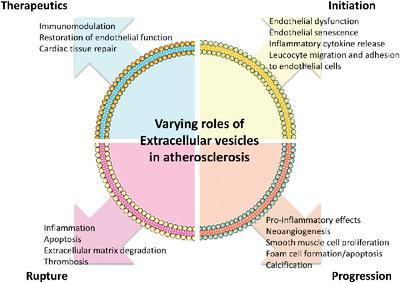当前位置:
X-MOL 学术
›
J. Leukoc. Biol.
›
论文详情
Our official English website, www.x-mol.net, welcomes your
feedback! (Note: you will need to create a separate account there.)
Role of extracellular vesicles in atherosclerosis: An update
Journal of Leukocyte Biology ( IF 3.6 ) Pub Date : 2021-09-08 , DOI: 10.1002/jlb.3mir0221-099r Pierre-Michaël Coly 1 , Chantal M Boulanger 1
Journal of Leukocyte Biology ( IF 3.6 ) Pub Date : 2021-09-08 , DOI: 10.1002/jlb.3mir0221-099r Pierre-Michaël Coly 1 , Chantal M Boulanger 1
Affiliation

|
Extracellular vesicles (EVs) are membrane particles released by most cell types in response to different stimuli. They are composed of a lipid bilayer that encloses a wide range of bioactive material, including proteins and nucleic acids. EVs have garnered increasing attention over recent years, as their role in intercellular communication has been brought to light. As such, they have been found to regulate pathophysiologic pathways like inflammation, angiogenesis, or senescence, and are therefore implicated in key aspects atherosclerosis initiation and progression. Interestingly, EVs appear to have a multifaceted role; depending on their cargo, they can either facilitate or hamper the development of atherosclerotic lesions. In this review, we examine how EVs of varying origins may be implicated in the different phases of atherosclerotic lesion development. We also discuss the need to standardize isolation and analysis procedures to fully fulfil their potential as biomarkers and therapeutics for cardiovascular diseases.
中文翻译:

细胞外囊泡在动脉粥样硬化中的作用:更新
细胞外囊泡 (EV) 是大多数细胞类型响应不同刺激而释放的膜颗粒。它们由脂质双分子层组成,该脂质双分子层包裹着多种生物活性物质,包括蛋白质和核酸。近年来,电动汽车越来越受到关注,因为它们在细胞间通讯中的作用已被曝光。因此,已发现它们可调节炎症、血管生成或衰老等病理生理途径,因此与动脉粥样硬化起始和进展的关键方面有关。有趣的是,电动汽车似乎具有多方面的作用。根据货物的不同,它们可以促进或阻碍动脉粥样硬化病变的发展。在本次审查中,我们研究了不同来源的 EVs 如何与动脉粥样硬化病变发展的不同阶段有关。我们还讨论了标准化分离和分析程序的必要性,以充分发挥其作为心血管疾病生物标志物和治疗剂的潜力。
更新日期:2021-09-08
中文翻译:

细胞外囊泡在动脉粥样硬化中的作用:更新
细胞外囊泡 (EV) 是大多数细胞类型响应不同刺激而释放的膜颗粒。它们由脂质双分子层组成,该脂质双分子层包裹着多种生物活性物质,包括蛋白质和核酸。近年来,电动汽车越来越受到关注,因为它们在细胞间通讯中的作用已被曝光。因此,已发现它们可调节炎症、血管生成或衰老等病理生理途径,因此与动脉粥样硬化起始和进展的关键方面有关。有趣的是,电动汽车似乎具有多方面的作用。根据货物的不同,它们可以促进或阻碍动脉粥样硬化病变的发展。在本次审查中,我们研究了不同来源的 EVs 如何与动脉粥样硬化病变发展的不同阶段有关。我们还讨论了标准化分离和分析程序的必要性,以充分发挥其作为心血管疾病生物标志物和治疗剂的潜力。











































 京公网安备 11010802027423号
京公网安备 11010802027423号